
|   |

|   |
Samakala: A Festival of Contemporary Dance - Dr. Sunil Kothari e-mail: sunilkothari1933@gmail.com Photos courtesy: Odisha Tourism June 17, 2012 At the very outset, let me congratulate Odisha Tourism, Dept of Culture, Government of Odisha and Odisha Sangeet Natak Akademi, Bhubaneswar, for organizing Samakala, a Festival of Contemporary Dance, from 11th till 13th June 2012 at Rabindra Mandap. And also for arranging a talk on Contemporary Dance by the renowned art critic Sadanand Menon to give a context for the event. For the first time, Odisha Tourism and Odisha Sangeet Natak Akademi has organized such a festival. There are few such festivals being held in India for contemporary dance genre and any such venture needs full support. The principal Secretary of Odisha Tourism, Mr. Ashok Tripathi, has won unqualified appreciation for his boundless enthusiasm and meticulous planning of dance and music festivals in Odisha and it has rightly won the epithet that Odisha is a state of festivals. Mr. Tripathi is seen all the time on his toes paying attention to all details of the organization and it speaks volumes for one person whose initiative has brought excellent focus on dance. Since the artistes come from various parts of India and some from abroad, the people of Odisha get an excellent opportunity to witness the latest in Indian dance. It also provides an opportunity for critics to watch the performances and for three evenings, have exciting exchange of views and discussions on development of contemporary dance in India. What is most striking to an outsider including the troupes visiting Odisha is the overall cleanliness at Rabindra Mandap. Some of us feel that this is the best auditorium named after Rabindranath Tagore, which is so well maintained. Wherever Gurudev Tagore is, he shall be showering blessings on all who keep this auditorium so spick and span! The way the venue is decorated with lighting, the big attractive posters of dancers at the gate and the foyer where the images of Lord Jagannath, Subhadra and Balabhadra are placed with lamp and flowers, generates an atmosphere of festivity and joy. The Utkal Sangeet Mahavidyalaya auditorium next door needs immediate attention in this matter, as the seminars and talks are organized there. In particular, the rest rooms and green rooms need immediate attention of the authorities. In contrast to Rabindra Mandap, it looks shabby and unpleasant. Since last year, I have been attending three to four festivals in Bhubaneswar and have enjoyed watching performances on stage presented with perfection, good lighting, announcements and they start dot on time. The lighting of the lamp is done, few introductory remarks and brief speeches are made and one is transferred to the world of colour, music, movement and a mood is set for delight. The audience takes seat peacefully and in pin drop silence, the performances follow in a smooth manner. Having given the readers this background, let us now go to the concept of Samakala, which was introduced every evening. "The word contemporary means 'at the same time as' and to really understand the need for contemporary dance, we need to have an insight into the socio-political and economic scenario of the world. While economy and politics recognize no boundaries, it would be myopic to expect dance to be held captive by boundaries.... Contemporary dance is not in its infancy. Pioneers like Isadora Duncan, Martha Graham have taken it across the globe into many parts. Having a festival of contemporary dance in Odisha would be a step in the right direction.... Contemporary dance is a style of expressive dance that combines vocabulary of several dance forms. This style of dance connects the mind and body. The human mind is dynamic and so contemporary dance is versatile and the product of improvisation." This observation provides some clue to the uninitiated in the audience to look at what they have not seen earlier. Also why it is different from classical dance forms. Since there are no regular platforms and venues for contemporary dance, these introductions are necessary and help audiences to enter the world of contemporary dance. The six groups which were invited comprised Bhoomika led by Bharat Sharma from New Delhi, Shankarananda Kalakshetra led by Ananda Shankar Jayant from Hyderabad, Stem Dance Kampni led by Madhu Nataraj from Bengaluru, and three troupes from Kolkata: Mamata Shankar's troupe led by Mamata Shankar, Tanushree Shankar's troupe led by Tanushree Shankar and Ballygunge Rhythmosaic School of Dance led by Ronnie Shambik Ghose and Mitul Sen Gupta. On the opening day on 11th June, Bharat Sharma, dancer, choreographer, teacher, writer, technician and administrator who has inherited his late father Narendra Sharma's Bhoomika dance company, presented Narendra Sharma's choreographic work 'Cranes,' which was first choreographed in early forties at Almora when Uday Shankar had shown the members of his company, movements of hands of Balinese dancers. The ardhachandra hasta turned downwards with arm suggesting neck and dancers moving it gracefully giving an impression of cranes flying, was quite mesmerizing. The troupe performed it with finesse and in typical Uday Shankar style. The movements of birds and various formations as seen in sky of flying "Balaka'' birds to the lilting music shows a historic landmark. 'Rangavali' also choreographed by Narendra Sharma, has four dancers, three females each dressed in national flag colours of saffron, white, green performing with cloth flowing in circular, horizontal, diagonal directions giving an illusion of national flag and the circular movements for chakra. It was well executed by dancers. One male dancer then enters with cardboard of chakra and moves in centre giving an illusion of the flag with Ashok chakra. Tripura Kashyap's choreography for street boys, unfortunately gave an impression of dance numbers bordering Bollywood dancing. The choreography needs to avoid that impression because the energy level of the dancers is praiseworthy. Bharat Sharma's own choreographic piece was an excerpt from 'Jatakamala.' The choreographer's note mentions: "Jataka tales of Buddhists expound on wisdom which has inter-connected tales, over 540 in number, written in the format of evolutionary cycle of Buddha's previous lives, and are closer to contemporary theories on 'Memory.' These tales touch upon a range of issues of its times - ecology, human relations, wisdom stories and a historical record of its times." Taking into account these, one looked forward to seeing images, which would give one glimpse of some of these in a vocabulary evolved by Bharat over the years. The evolutionary cycle reminded of earlier works of Narendra Sharma, in particular movements of monkeys and birds et al. The training of the troupe is praiseworthy but the execution in terms of imagination and giving shape to ideas remained blurred. The use of cloth, scarves, sticks, remind one of Bhoomika's signature but in the final analysis did not add up to further progress. At best, the works presented gave one a historical idea of how from Uday Shankar's attempts of early forties contemporary dance had evolved. The use of saffron colour costumes, movements reminding of Eastern countries, Bali, Javanese, Cambodian dance movements and esoteric music were in tune with suggested concept of Jatak tales. 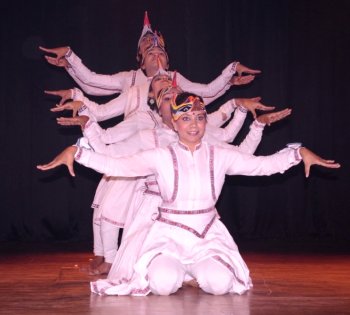 Cranes 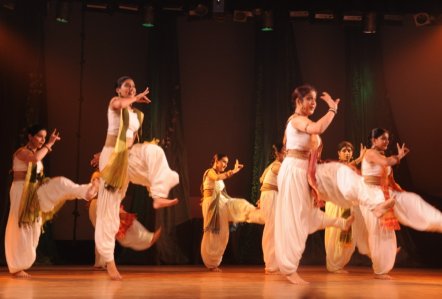 Dancing Tales - Panchatantra Ananda Shankar Jayant's 'Dancing Tales - Panchatantra' had narratives, which were easy to follow and since the work was commissioned years ago keeping in mind the young crowd, the choreographer had a field day dwelling upon the stories which had instant appeal. The dance vocabulary of Bharatanatyam and Kuchipudi along with free movements, a variety of costumes for world of animals and birds, forest dwellers enhanced the visual impact. The classical dance movements, with melodious music were all dovetailed to entertain the audience. There were memorable touches about critique of walking on ramp, when wife of crocodile walks seductively, waving her jada a la, Satyabhama. Crocodile taking back monkey to tree 'where monkey had left his heart' was well conceived, the birds flying with net, dancers' heads popping out of net, dancing number like tillana and several other images were choreographed imaginatively. But somehow the narrative did not fit in the concept of Samakala, contemporary dance genre. Since the evening began with flying birds, cranes, and there were movements of animals in Jatakamala, and an abundance of it in Panchatantra, the juxtaposition took away from enjoying the work on its own merit. It looked too long-winded and predictable on account of the nature of the story. Ananda has other interesting abstract works under her belt, which fall in contemporary genre category. Drishti, Navarasa to name a few would have created better impact for discerning audience looking for contemporary work. Bhinna ruchir janah: audiences have varied taste, says Bharatamuni. Therefore Panchatantra, doubtless, was received with applause. To Ananda's credit it must be said that her troupe consisted of young people from diverse educational background and one marvelled at her ability to get them to perform the production with varied movements. The second day began with Madhu Nataraj's choreographic work called 'Sankalan.' A compilation of the latest choreographic works, it included a collaborative mixed media work capturing and radiating various nuances to the term 'Vajra' for which Madhu had worked with her versatile team of young dancers. Daughter of legendary Maya Rao, disciple of Shambhu Maharaj, Madhu uses Kathak with professional ease and aplomb. The vocabulary of Kerala martial art Kalaripayattu, Maibi, Thang-ta of Manipur, use of graphics, lighting, written text running across the screen, human pyramid, yoga, tantric images of goddesses like Chinnamasta, images following one after another in a seamless manner, helped Madhu's work give audience a glimpse into in what direction her work moves. Of course, those exposed to Aditi Mangaldas's and Chandralekha's choreographic pieces could see the resonances in Vajra in some sections. But this phenomenon is natural. Blind imitation would be inartistic and would go against the artistic work and its integrity. Madhu is aware of it and her group created favourable impression. 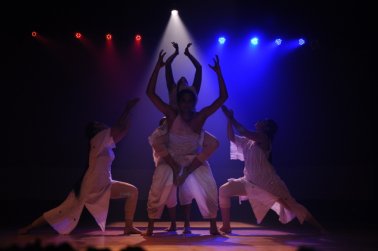 Sankalan 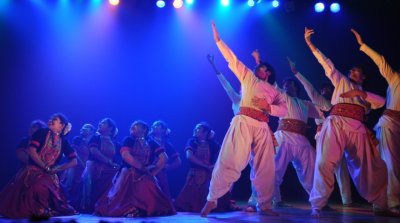 Amritasya Putra Mamata Shankar and her troupe had 'a head start.' Being the daughter of the legendary Uday Shankar, 'the father of modern and contemporary dance', Mamata has kept the legacy alive of her father's style and scope, dimension and imagination. In 'Amritasya Putra,' she deals with basic emotions, life, travails, high and lows and pain, suffering, and finally out of repentance, inner search starts to realize the ultimate truth that we are spark of divinity - Amritasya Putra. The production was spectacular. The showmanship was breathtaking. Lighting design, group movements, use of stretch cloth, dancers standing one behind another, creating visuals, with cloth descending from top to bottom, figures emerging, life in a village with joyous, vigorous dancing, groups emerging with loosened hair, black mood pervading, anarchy, riots, devastation, killing of children, heart wrenching cries of mothers, all in sequences succeeding one after another and finale with hope lighting up humanity, were danced by the troupe under Mamata Shankar's direction. The production also revealed some traits of early times. The melodrama, women crying loudly, screaming, falling on the floor, a dead child being taken in arms, loud gestures of spreading arms, looking upwards etc., detracted from the artistic design. The plastic doll for a child held in arms looked incongruous as the cries of the mothers. The sudden English commentary came breaking the spell. Earlier, it was announced that the production is based on instrumental music only and there are no spoken dialogues. Therefore, the commentary did not fit in. The movements spoke of agony and ecstasy. If these elements were carefully thought over, the production in typical Uday Shankar genre would remain more true to Uday Shankar's spirit. The teamwork was commendable and disciplined. On the final day, Tanushree Shankar, daughter-in-law of Uday Shankar, presented 'The Child' based on Gurudev Tagore's only long English poem. Victor Bannerjee's emotional rendering suited the mood and unfolding of the ten sequences of stanzas with flawless, seamless group movements of boys and girls. With Tanushree's typical graceful, three bend body movements of female dancers, seated, standing, diagonally moving or in straight line, in curves, circles, taking off from Uday Shankar technique in which she was groomed, retaining the spirit of style and freedom, Tanushree succeeded in choreographing the work, highlighting Tagore's concepts. Abstract as well as intellectually provoking, Tagore's poem has been interpreted as man's journey from darkness of ignorance, hopelessness and desperation of life, to the light of knowledge and understanding, full of turmoil, doubt and treachery. Tanushree dwells on fragile hope and faith that takes man on his continuous journey. The newness of life is represented by the child, full of innocence and simplicity. The rhythmic flow from the bondage of ignorance finds ultimate freedom of enlightenment and self-realization. Tanushree also feels that the poem is a celebration of the mother - the feminine principle in the universe. Such a concept when translated into dance movements with narration and music involves several inputs from various people. Tanushree has used rhythmic movements, also patterns in diagonal direction, source of light from one end of the stage (lights by Dinesh Poddar), often turning in that direction through various passages. Dancers change costumes quickly and emerge on the stage, move vigorously, taking leaps in the air or roll on the floor energetically. The exits and entries are uncluttered and smooth. The music by Debojyoti Mishra is used effectively. The choral singing of 'Ave Maria' creates a mood of prayer, the arrival of hope and feeling of enlightenment. Recitation of 'He Janani' in Bengali extolling feminine principle of mother is effective in enhancing the prayer. Generally on the Indian group dance scene, one does not see so many dancers creating "a mass." The mass movement at times is hypnotic. In the west, large numbers of dancers are employed in a company. Tanushree and Mamata Shankar are fortunate to have large number of dancers both male and female. And they together create a body of movement, which is visually stunning. 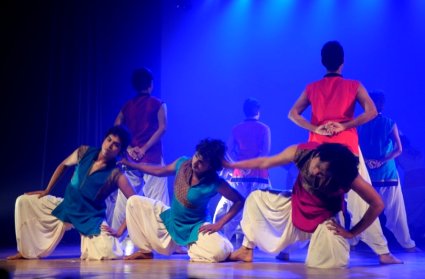 The Child 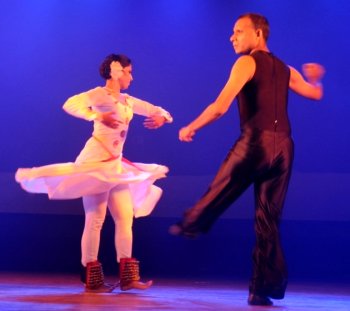 White The finale 'White' was choreographed by young dancers Ronnie Shambhik Ghose and Mitul Sengupta. Ronnie is a graduate from The Hong Kong Academy for Performing Arts with major in musical theatre dance. He has teamed under great masters as Md. Drissi and Gianin Loringett, father of classical Jazz dance. Mitul Sengupta, a national scholar of Kathak, has studied Kathak from Kalakriti Samskriti Foundation in New Delhi and has a doctorate in psychology. She is trained in Flamenco and Jazz and these two dancers have combined their talent in grooming a group of young dancers bringing fresh work on the contemporary stage. Mitual is a versatile dancer exceptionally graceful, rhythmic and strong. Her Kathak has all the nazakat and khubsoorati, grace and beauty but she has imbued it with quality of jazz and sparkle. It leaves an indelible impression. Ronnie has a strong manly stance, demeanor and performs with perfection, stamina and speed. The group is well trained and they dance with zest. The title 'White' is only a peg around which they have choreographed dance movements which are energetic and choreographers have kept in mind the aesthetics of Kathak and western classical and contemporary dance techniques, including classical jazz, classical ballet, techniques of Jose Limon, Graham and Cunningham. Tap dance and lyrical flamenco are also interwoven. This myriad vocabulary was expressed with competence. Of course with her movements, Mitul won applause for her talent. Ronnie with his exposure to the west and tutelage under great masters displayed what he can do with Indian dance forms. Their duets, group dances, coming from one side of the stage and running to other side, had indeed a look of a contemporary dance as seen in the west, but it essentially displayed very Indian quality. It was a good sign to see the festival throwing up such new, fresh, young talent carrying forward the contemporary dance. In a curious way the festival began with Uday Shankar's disciple Narendra Sharma's choreographic work and ended with Ronnie and Mitul's work. In between one saw also Uday Shankar's daughter and daughter-in-law's works and it provided a framework, which could be discussed at length. In his lecture, Sadanand Menon gave a brief history and spoke of historic moments, how dance in India has history of hundred years only and no worthwhile attempts are made to seriously study the history or write about it. The 'erasers' are there in absence of archival material, recorded history, we have no idea of the past and are at times at a loss as to how to negotiate for new creative collaborations and works in dance. While introducing him, I had mentioned how in 1984 at NCPA in Mumbai, we had gathered together with artistes from the West and discussed about contemporary dance, new directions in Indian dance. Chandralekha, Kumudini Lakhia, Astad Deboo, Uttara Asha Coorlawala, Ileana Citaristi, Mrinalini Sarabhai from India and many dancers from the West were there. Sadanand said about Susanna Linke from Bremen, Germany, an exceptionally gifted dancer, who spoke of dance stating when you dance on stage in the centre, it is Ok, when in front, Ok but when you dance on the edge of the stage, it is risky. That risk creates dance. She had danced her new work a few times in Germany. She worked on the floor but when she danced, it looked like she was floating above the floor. That was a technique she had evolved. This East West Encounter was a memorable event. Works of Chandralekha received great support from then on. Sadanand also spoke about why it is important to have reference material, history and how in its absence, erasers take place. He screened Ein Lall's film 'Sharira' made for PSBT (28 minutes) on Chandralekha and her work, which was seen for the first time in Bhubaneswar, though it was included in Jatin Das's documentary film festival, but had not been discussed in this context. Sadanand drew attention to the fact that such festivals must be curated with great care and must have discussions and participation by critics and dancers, gurus and others interested in dance. Any festival, which gives importance to contemporary dance movement in India, is most welcome. Mr. Samal, Minister for Culture and Tourism, attended the festival for all three evenings. Principal Secretary of Tourism Mr. Ashok Tripathi, President Sarat Pujari, Vice President of Odisha Sangeet Natak Akademi Aruna Mohanty, secretary of Odisha Sangeet Natak Akademi Mr. Chittaranjan Mallia, deserve congratulations for their initiative. They looked after artistes well and provided good lighting and other facilities, recognizing that technology plays an important part in contemporary dance. The minister announced that from this year, the festival of contemporary dance would be an annual feature in the cultural calendar of Orissa. It will also be presented in Cuttack and Puri.  Dr. Sunil Kothari is a dance historian, scholar, author and a renowned dance critic. He is Vice President of World Dance Alliance Asia Pacific India chapter, based in New Delhi. He is honored by the President of India with Padma Shri, Sangeet Natak Akademi award and Senior Critic Award from Dance Critics Association, NYC. He is a regular contributor to www.narthaki.com, the roving critic for monthly magazine Sruti and is a contributing editor of Nartanam for the past 11 years. Responses Opinions of the critic and all responses are the sole opinions of the writers. * June 23, 2012 We are both amused and appalled at this particular section of Sunil ji's review of our work 'Sankalan' at the 'Samakala' festival. We are shocked at his statement. Of course, those exposed to Aditi Mangaldas's and Chandralekha's choreographic pieces could see the resonances in Vajra in some sections. But this phenomenon is natural. Blind imitation would be inartistic and would go against the artistic work and its integrity. Madhu is aware of it and her group created favourable impression. We are honest artistes and are open to receiving both brickbats and bouquets for our work and to willingly learn from our mistakes, but remarks made by biased minds attacking our integrity are unacceptable. Sunil ji says our Kampni received a "favourable impression" from the audience. Well, a spontaneous standing ovation from the audience (not a standing ovation prompted by comperes, which have become the norm nowadays!), congratulatory calls from the Odisha Tourism and information ministries, from the audience and a few scholars for a week after the festival is not just 'favourable.' Sunil ji himself went up on stage and praised the Natya & STEM Dance Kampni's performance and used several superlatives! The whole event was documented by the wonderful organisers of the festival. Added to that is the fact that he personally congratulated us profusely. So this rather twisted review is shocking. What really angers us is the cleverly cushioned allegation that we imitate Aditi Mangaldas or the late Chandralekha. The iconic Chandralekha is someone we hold in very high regard. Unfortunately, our dancers have not had the opportunity to view her choreography. I too last saw her work over 17 years ago. We occupy such different spaces in different times... so in all honesty how can we feel any affinity to her work? We really admire Aditi as a wonderful dancer but hers and our work have nothing in common except for our chosen medium - Kathak. So if anyone's work is informed by Kathak, Yoga, Indian martial arts and they are cerebrally inclined and are inspired by both contemporary and esoteric texts in the communication of their vocabulary...then they are copying, oh sorry 'resonating' the above mentioned artistes' style? Many brilliant minds, old and new from the field of dance, music, design, architecture and new media and their artistry inspire us and we often invite them to collaborate with us. As artistes we strive to create our own alphabet. Actually, we are very inspired and influenced by my mother and Guru Maya Rao's ideology but even that does not show up in our work because we endorse the need to be original. The performance of 'Sankalan' in Odisha includes work that is backed by years of research along with the contribution of almost 15 amazing collaborators and consultants. This is an insult to them too. We constantly assess our own work, acknowledge our weaknesses and strengths and believe we have to compete with ourselves to grow and to strive for completeness in our work. We have no problem if one berates our work because that is a choice, opinion or conjecture even, but accusing us of plagiarism and of masking it with our 'intelligence' is not acceptable at all! Madhu Nataraj and The Natya & STEM Dance Kampni Founder Director, Educator & Arts entrepreneur stemdancekampni.in * July 4, 2012 Below is my response to Madhu Nataraj's comments. "Of course, those exposed to Aditi Mangaldas's and Chandralekha's choreographic pieces could see the resonances in Vajra in some sections. But this phenomenon is natural. Blind imitation would be inartistic and would go against the artistic work and its integrity. Madhu is aware of it and her group created favourable impression." When a critic with wide terms of references and exposure, comments he only gives a broad perspective. Therefore my references to Aditi Mangaldas and Chandralekha are mentioned as resonances - not imitation, and I have given reasons for that as a phenomenon. I do not imply that you are IMITATING and I have said that YOU are aware of what imitation would mean. We are honest artistes and are open to receiving both brickbats and bouquets for our work and to willingly learn from our mistakes, but remarks made by biased minds attacking our integrity are unacceptable. There is no biased mind nor do I attack your honesty or integrity. I have stated my impression. Sunil ji says our Kampni received a "favourable impression" from the audience. Well, a spontaneous standing ovation from the audience (not a standing ovation prompted by comperes, which have become the norm nowadays!), congratulatory calls from the Odisha Tourism and information ministries, from the audience and a few scholars for a week after the festival is not just 'favourable.' I am aware of it and I consider 'favourable' as positively good, complimentary response. Sunil ji himself went up on stage and praised the Natya & STEM Dance Kampni's performance and used several superlatives! The whole event was documented by the wonderful organisers of the festival. Added to that is the fact that he personally congratulated us profusely. So this rather twisted review is shocking. What really angers us is the cleverly cushioned allegation that we imitate Aditi Mangaldas or the late Chandralekha. If I spontaneously complimented the work and your dancers, I meant every word of it. There is nothing to get angry about references to Aditi Mangaldas's work and Chandralekha's work referred to by me in my review. I have not cleverly cushioned allegation that you are imitating Aditi Mangaldas and Chandralekha. The iconic Chandralekha is someone we hold in very high regard. Unfortunately, our dancers have not had the opportunity to view her choreography. I too last saw her work over 17 years ago. I am glad you hold her in high respect. If the impressions are registered earlier of her work, there is nothing wrong about it. Your young dancers may not have seen her, but if I felt the resonances in your work, that does not mean that THEY are copying / imitating Chandralekha! We occupy such different spaces in different times... so in all honesty how can we feel any affinity to her work? It is true you occupy different spaces and times but affinity to Chandralekha's work in some sections could be pinpointed out. If a critic feels some resemblance to it, as I have said, it does not mean imitation. We really admire Aditi as a wonderful dancer but hers and our work have nothing in common except for our chosen medium - Kathak. So if anyone's work is informed by Kathak, Yoga, Indian martial arts and they are cerebrally inclined and are inspired by both contemporary and esoteric texts in the communication of their vocabulary...then they are copying, oh sorry 'resonating' the above mentioned artistes' style? Aditi, Daksha, both Kathak dancers, have used striking their bodies with palms and creating sounds and if it is seen also in your work, reference to that suggests that a critic sees resonances of it in your work. If that is considered by the choreographer as unacceptable comment, then we can have NO dialogue. Many brilliant minds, old and new from the field of dance, music, design, architecture and new media and their artistry inspire us and we often invite them to collaborate with us. As artistes we strive to create our own alphabet. Actually, we are very inspired and influenced by my mother and Guru Maya Rao's ideology but even that does not show up in our work because we endorse the need to be original. Unfortunately a choreographer gets touchy about comments and misreads them, and a critic has to take this also in his stride. Acknowledging Maya Rao's legacy does not diminish value of your work. Originality is indeed a God's gift. We are exposed to so many things and if references to it are mentioned, a choreographer must not read too much in it as biased and an attack. The performance of 'Sankalan' in Odisha includes work that is backed by years of research along with the contribution of almost 15 amazing collaborators and consultants. This is an insult to them too. We constantly assess our own work, acknowledge our weaknesses and strengths and believe we have to compete with ourselves to grow and to strive for completeness in our work. We have no problem if one berates our work because that is a choice, opinion or conjecture even, but accusing us of plagiarism and of masking it with our 'intelligence' is not acceptable at all! I have no doubt about your work, your struggle to evolve your own dance vocabulary, for past several years. I did not suggest any insult to any of your 15 amazing collaborators. I have not even suggested plagiarism. Resonances are not plagiarism. If you believe in a critic's response to your work, you would not give this long explanation. Unfortunately, dance criticism in India does not grow with passage of time. Any comment if interpreted in the way it has been in this case with one word like 'resonances,' then a critic is helpless to convince a choreographer that in spite of his impression, he admires the work. If it were not so, I would not have complimented you on stage. Both are different occasions and one is discreet enough about admiration and criticism. You have misread it and unnecessarily misunderstood it as an attack and mentioned so many things about your work for past so many years of which I am aware and have admired. So I am sure you shall banish all misunderstandings. - Sunil bhai (Sunil Kothari) Post your comments Pl provide your name and email id along with your comment. All appropriate comments posted with name and email id in the blog will also be featured in the site. |